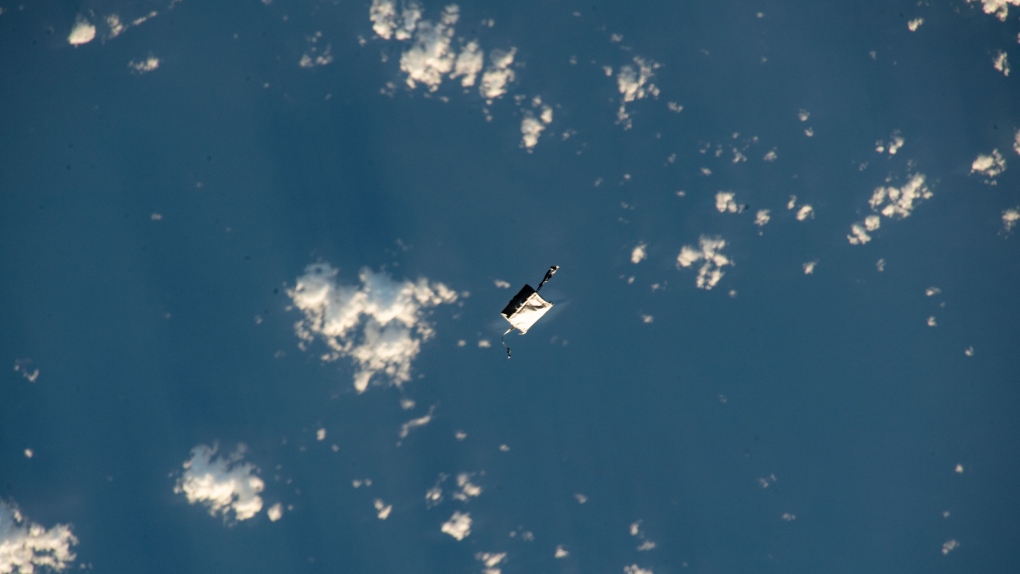Add "bag of tools" to the list of objects currently orbiting Earth. And no, this isn't the set-up for a joke.
NASA astronauts Jasmin Moghbeli and Loral O’Hara were conducting a spacewalk and performing maintenance on the outside of the International Space Station on Nov. 1 when their tool bag drifted away from them and into the empty space beyond.
NASA confirmed the incident in a blog post about the space walk.
"During the activity, one tool bag was inadvertently lost. Flight controllers spotted the tool bag using external station cameras," the agency wrote. "The tools were not needed for the remainder of the spacewalk."
European Space Agency reserve astronaut Meganne Christian shared footage of the moment the tool bag drifted away from Moghbeli in a post on X, formerly known as Twitter, on Nov. 5. At that time, she said the bag had last been spotted by Japan Aerospace Exploration Agency astronaut Satoshi Furukawa as it orbited high above Mount Fuji.
NASA said Mission Control analyzed the bag’s trajectory and determined that risk of it colliding with the station is low and that the station and crew are safe. According to earthsky.org, the bag is expected to remain in orbit for several months, gradually descending until it reaches Earth's atmosphere where it will most likely disintegrate.
The bag is highly reflective, so as it loses height, it should become visible to Earth-bound onlookers. Here are some tips for catching a glimpse of the tool bag.
TRACK THE TOOL BAG'S LOCATION
Jonathan McDowell, astronomer and astrophysicist at the Harvard–Smithsonian Center for Astrophysics, confirmed last week that the bag has been catalogued by the U.S. Space Force and assigned the catalogue number 58229/1998-067WC.
It's officially being tracked as a new orbital object, and anyone with an internet connection can monitor its location in real time via the satellite tracking site N2YO.com. Although the N2YO profile for the tool bag lists the launch date as Nov. 20, 1998, McDowell, who is familiar with the site, said the profile is, indeed, for the bag lost earlier this month.
"Their 'launch date is 1998' info was generated from fact that the international designation is in the 1998-067 series (1998-067A is the first ISS element, the Zarya module)," he said in a post on X, formerly known as Twitter. "But that's how all ISS released objects are designated."
You can also figure out when the tool bag — technically known as a "crew lock bag" — will pass overhead by tracking the location of the ISS and planning to look up a few minutes before the space station is expected to pass by. As it loses height, the tiny satellite should appear between two and four minutes ahead of the ISS.
GET OUT THE BINOCULARS
With a stellar visual magnitude of around six, according to EarthSky, the bag is a little dimmer than the planet Uranus. As a result, it's not quite bright enough to be visible to the naked eye, but night sky watchers should be able to spot it with a pair of binoculars.
 A tool bag lost during a spacewalk outside of the International Space Station is seen drifting through space. (Satoshi Furukawa / Earth Science and Remote Sensing Unit, NASA Johnson Space Center)
A tool bag lost during a spacewalk outside of the International Space Station is seen drifting through space. (Satoshi Furukawa / Earth Science and Remote Sensing Unit, NASA Johnson Space Center)
Simply figure out when it is due to pass overhead in the night sky and look up. The bag is currently orbiting Earth once every 92 minutes at a distance of between 419.2 and 421.6 kilometres.
NOT THE FIRST TOOL BAG IN SPACE
This isn't the first stray tool bag to orbit Earth. In 2008, a briefcase-sized tool bag came untethered and drifted away from astronaut Heidemarie Stefanyshyn-Piper as she performed maintenance on the space station's solar panels.
"What it boils down to is all it takes is one small mistake for a tether not to be hooked up quite correctly or to slip off, and that's what happened here," said lead spacewalk officer John Ray at the time.
The bag was one of the largest items ever lost by a spacewalking astronaut and NASA estimated its value was about $100,000.
Astronauts have lost other items in space, too. CNN reports that the list of junk set adrift during space walks on the ISS includes a thermal cover, two tools, a bolt, spring, washer and a 14-inch spatula.
In fact, the European Space Agency reported in September that there were 35,290 debris objects in space being tracked by Space Surveillance Networks and maintained in their catalogue.
Including both space junk and satellites launched into orbit, the agency estimates that the total mass of all space objects in Earth orbit is more than 11,000 tonnes.











































